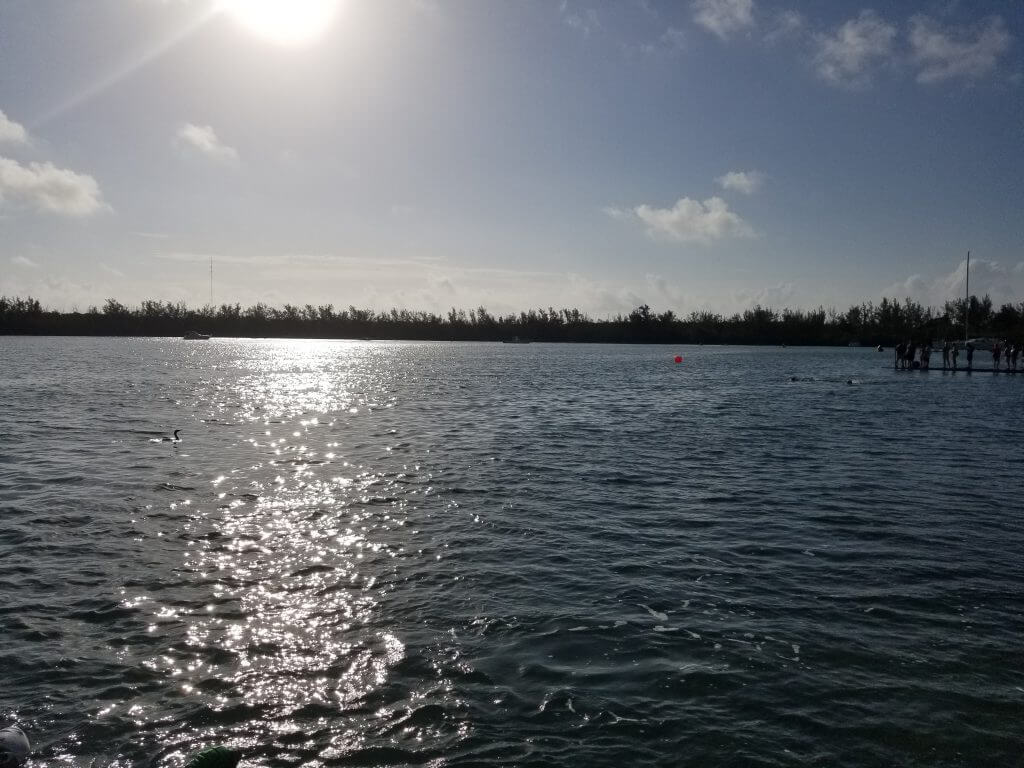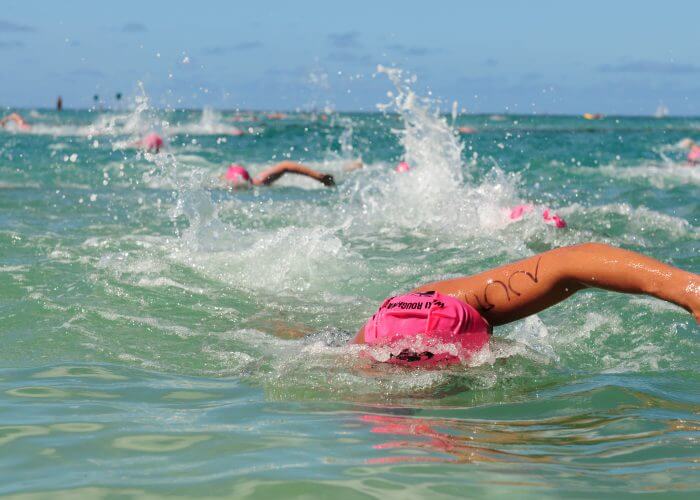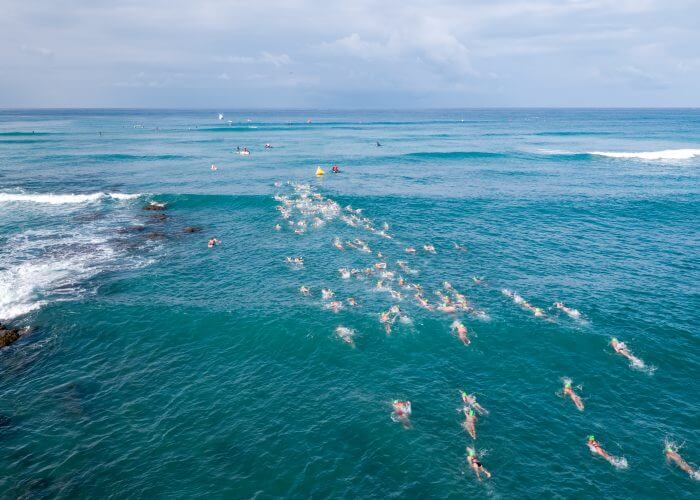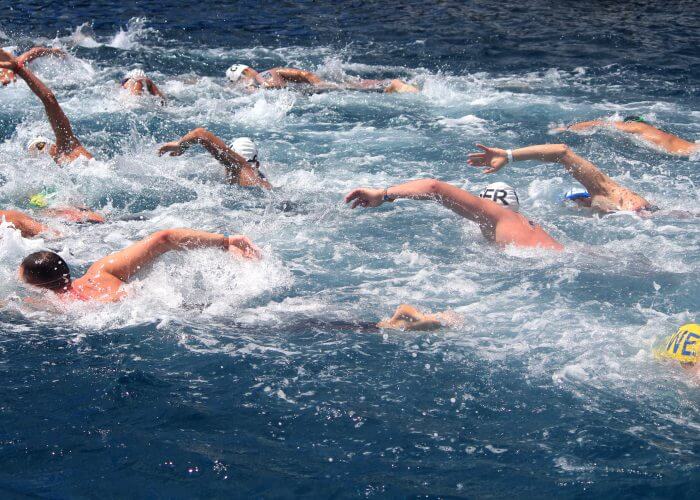What is SIPE And Why Should Open Water Swimmers Care?

By Claire Alongi, Swimming World College Intern.
When people think of going for a swim, they typically picture diving into a 25-meter chlorinated pool instead of a vast expanse of open water. While the former type of swimming is highly publicized, the latter has a niche of its own. Open water swimming requires much different preparation in both training and safety concerns.
Open water swims are usually about endurance and mind over matter. But sometimes, mentality isn’t enough to get you to the finish line. There’s an element of unpredictability in open water races, no matter how experienced the swimmer. People expect to get tired or cold during an open water swim; however, one experience that swimmers and safety personnel may not be aware of is swimming induced pulmonary edema (SIPE). It is potentially a fatal condition if it goes unrecognized and untreated. Swimmers should not be detracted from delving into the excitement of open water swimming; however, they should be aware of the dangers, signs and treatments. It just might save a life.
What is SIPE?

Photo Courtesy: Waikiki Rough Water Swim
Pulmonary edema is a condition where fluid collects in the lungs. Specifically, swimming in colder open water can trigger it. In addition to surface swimming, SIPE is also linked to scuba diving, snorkeling, and free diving. Symptoms of SIPE include coughing, shortness of breath, chest pain or tightness, and – in some cases – hemoptysis (coughing up blood). It can be fatal, but typically symptoms lessen after leaving the water and are completely gone within 48 hours.
In its own way, SIPE is a bit of a mystery. Individuals with hypertension may be more at risk. Otherwise, it tends to affect people that may have a totally blemish-free health history. It has not been studied in extreme depth yet, although that’s slowly changing as higher incident rates of what is most likely SIPE are reported. There also hasn’t been much research on how different types of water activities (i.e. surface swimming vs. free diving) may impact SIPE. Much more additional research must be undertaken to truly understand the condition.
SIPE Happens… And Sometimes It Doesn’t

Photo Courtesy: Jonas Gutzat
Kristen Kiely Gillfillan participated in her fist open water swim when she was 24 and has kept it up for the last 26 years. She has traversed Lake Berryessa, Lake de Valle, and Trans-Tahoe one time each and Donner Lake over 20 times. Once her daughter turned 18, she began accompanying Gilfillan on the Donner swim.
Gilfillan grew up on the shores of Lake Tahoe in the 1970s. Her father was a sailor, and she described the lake as being “her front yard,” both of which contributed significantly to her love of the water.
“I learned to swim, ski, and walk all at the same time,” Gilfillan said. But her initial foray into open water swimming was spurred on by loss. “When I was twenty-four, my father was dying of lung cancer and I needed an emotional reset. So I heard about the Donner Lake swim and jumped in and did it. The simple answer to why I still do it is because I can […] It also reminds me I’m alive,” she said.
Gilfillan has never heard of, nor experienced SIPE. The extent of her struggles during a race has been difficulty breathing in choppy water, but she’s not exactly surprised to hear that SIPE exists.
Knowing the Risks and Moving Forward

Photo Courtesy: Vanessa Lucas- Seychelles Tourism Board
“It has not and will not change my attitude towards [open water] swimming. I am a scuba diver familiar with the idea of the ‘bends’ (nitrogen leaking where it should not during decompression), pulmonary edema through my medical training, and HAPE (high altitude pulmonary edema) [which is] fluid building up in the lungs of mountain climbers in the death zone,” Gilfillan said.
On the other hand, endurance triathlete Katherine Calder-Becker described at length in a blog post that she has suffered several times from SIPE. On one occasion, she began coughing up what she describes as pink foam. She also detailed her participation in a Duke study to better understand SIPE. Upon completing the study, she learned that one of her possible risk factors for SIPE is mild hypertension. On a brighter note, the study also found that she, like others who suffer from SIPE, can take Sildenafil (Viagra) to reduce the chances of experiencing SIPE. This medication was originally developed to treat pulmonary hypertension by relaxing the vessels to allow for increased blood flow.
The Takeaway
Learning about SIPE is not meant to scare open water swimmers out of participating in races. What it should do is serve as a reminder for swimmers to pay attention to their body. It’s important to be able to distinguish between regular tiredness versus what might be a sign you should flag down some help. Experienced swimmers might think they’re invincible in the water; however, SIPE and other unexpected internal or external complications can affect even the most experienced of swimmers. They don’t care if you’ve swum a race once or 100 times.
With this in mind, Gilfillan resolutely plans to continue swimming Donner Lake until her final days. “I intend to keep doing Donner yearly until I don’t emerge someday. I realize this is a pipedream, because I would never do that to the race organizers, but it is a nice dream,” she said.
On a lighter note, Gilfillan looked back on her nearly three decades of open water races and reflects, “In the middle of every race, I roll over and lie on my back to float for a few minutes […] I look at the sky and the mountains while alone in the middle of the lake and feel that is where I belong and am truly at peace.”
To learn more about the world of open water swimming, the World Open Water Swimming Association (WOWSA) publishes a monthly magazine, gives out yearly awards and maintains a dictionary of open-water-specific terms. Open water swims take place in various locations, including oceans, lakes, bays, rivers and more. They range in distance from mere hundreds of meters, to traversing miles upon miles of open water between landmasses.
-All commentaries are the opinion of the author and do not necessarily reflect the views of Swimming World Magazine nor its staff.




This condition is what is believed happened to me on 3/10 during an Olympic length triathlon in Florida. One minute I was swimming fine the next minute I felt as though I couldn’t get any air into my lungs and my extremities felt as though they were no longer working. I had no idea how hypoxic I was until the lifeguards forced me out and the paramedics found my 02 to be 79%. they gave me oxygen with Albuterol and Atrovent and I proceed to cough up pink tinged frothy sputum with an audible wheezing for the next 2 hours. once everything was coughed up I felt better. I have been doing tris for 19 years. This has never happened before. One thing I think I did differently is I did hydrate with extra precaution this race due to the high temps. Several people had DNF’d the previous day due to heat exhaustion.
I just experienced this yesterday during my first Tri. I am a very experienced swimmer. I have hypertension and the water surface temp was approximately 68-70 degrees. It was cold enough to initially take your breath away. About 100 meters out, I starting having trouble breathing and wheezing. I had to cough just to breathe. I believe I also aspirated a large amount of lake water as well. I stopped and held onto each kayak or sup starting about halfway to try and catch my breath. That was the longest 500 meters ever! When I got out, I had a hard time walking due to extreme dyspnea. I coughed up a lot of water and orangish/pink sputum. I was stubborn and continued to push myself and get on the bike. I made it 8 miles (pushing my bike up each hill) before turning around. Looking back on all this, I should have not continued and got the medical help I needed. I most likely injured my lungs. Ended up in the emergency room 8 hrs later. Lesson learned, listen to your body not your mind. This will not stop me from doing another one!